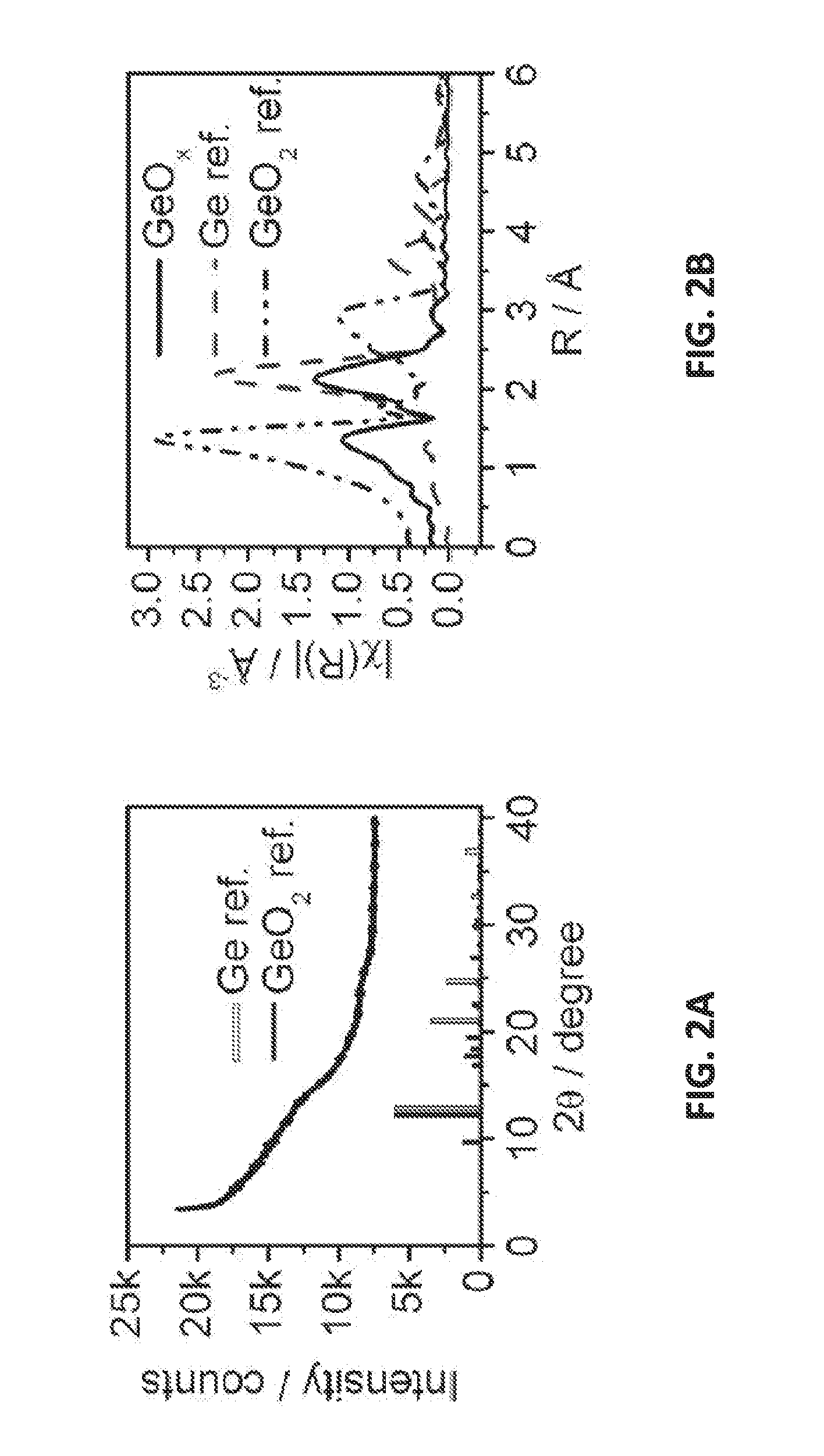POROUS AMORPHOUS GeOx AND ITS APPLICATION AS AN ANODE MATERIAL IN LI-ION BATTERIES
a technology of porous amorphous geox and anode material, which is applied in the direction of non-metal conductors, cell components, conductors, etc., can solve the problems of battery degradation, prohibitively large and heavy batteries, and prevent the use of these materials in commercial applications, etc., to achieve enhanced cycling stability, high diffusivity of lithium, and high capacity
- Summary
- Abstract
- Description
- Claims
- Application Information
AI Technical Summary
Benefits of technology
Problems solved by technology
Method used
Image
Examples
example 1
[0049]Amorphous GeOx agglomerates were prepared in ammonia solution at room temperature by a modified procedure previously used for preparing worm-like crystalline Ge nanostructures (Jing, C. B. et al. Nanotechnology 20, 505607 (2009), incorporated herein by reference in its entirety). The synthesis begins with the formation of germanate ions by reacting GeO2 with NH4OH, and the subsequent reduction of these ions using NaBH4. First, 8 g GeO2 (99.999%, Aldrich) was stirred in 144 ml distilled water. After adding 16 ml NH4OH (28.0-30.0% NH3, Alfa), the dispersion became transparent. Then, a fresh NaBH4 (98%, Alfa) solution (14.464 g in 80 ml water) was injected into the solution. The mixture was stirred continuously for about 20 hours. The resulting powder was collected by filtration, washed with distilled water, and dried under vacuum.
example 2
[0050]FIGS. 1A-1C illustrate the synthesized hierarchical porous nanostructure. The structure of the prepared amorphous germanium oxide agglomerates was examined using Hitachi S-4800 scanning electron microscope (SEM) and a JEM-2100F transmission electron microscope (TEM). The energy dispersive X-ray spectroscopy (EDS) was used in the TEM for measurements in the scanning transmission electron microscopy (STEM) mode. The low-magnification SEM image in FIG. 1A shows micrometer-sized agglomerates having a plurality of nanopores. As depicted in FIG. 1B at higher magnification, there are about 50 nm-sized nano-agglomerates. Further increasing magnification as illustrated in FIG. 1C under TEM shows the presence of 3.7±1.0 nm primary nanoparticles. Nitrogen-absorption measurements using a TriStar II 3020 analyzer determined a Brunauer-Emmett-Teller (BET) surface area of 187 m2 / g.
example 3
[0051]High-resolution synchrotron X-ray diffraction (XRD) measurements confirmed the amorphous structure of the materials prepared in Example 1. The synchrotron X-ray diffraction experiments were carried out on beamline X14A (λ=0.72958 Å) of the National Synchrotron Light Source (NSLS) at Brookhaven National Laboratory. The diffraction patterns were collected in a Q-range from 0.5 to 8.7 Å-1, with a Si strip detector at a 0.005° step-size. The initial GeOx sample was loaded in a single-crystalline sapphire tube, and the (de-)lithiated samples were loaded in glass capillaries.
[0052]Powder X-ray absorption samples were prepared by brushing the powders on to Kapton tape and stacking the tape to optimize absorption. The amorphous sample was measured in fluorescence mode as prepared, while the reference samples were ground and sieved through a 500 mesh and measured in transmission mode. The Ge K-edge X-ray absorption data were collected at NSLS X11A beamline using a Si(111) double-crysta...
PUM
| Property | Measurement | Unit |
|---|---|---|
| diameter | aaaaa | aaaaa |
| diameter | aaaaa | aaaaa |
| diameter | aaaaa | aaaaa |
Abstract
Description
Claims
Application Information
 Login to View More
Login to View More - R&D
- Intellectual Property
- Life Sciences
- Materials
- Tech Scout
- Unparalleled Data Quality
- Higher Quality Content
- 60% Fewer Hallucinations
Browse by: Latest US Patents, China's latest patents, Technical Efficacy Thesaurus, Application Domain, Technology Topic, Popular Technical Reports.
© 2025 PatSnap. All rights reserved.Legal|Privacy policy|Modern Slavery Act Transparency Statement|Sitemap|About US| Contact US: help@patsnap.com



